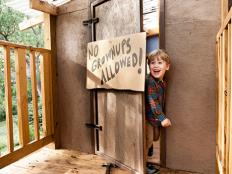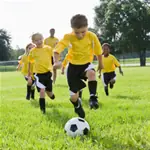
Winter has us thinking of frost, snow and limited time outside. So we put together a series of projects that would be good inside or out, that draw on art, science and imaginative play.
From playing with and investigating different materials on ice, to building your child's own winter wonderland city with recyclable materials, you're likely to find something that will spark their interest and creative mind for hours.
Melting Ice With Salt and Watercolor (or Food Coloring)
The science behind the use of salt to keep roads safe in freezing conditions is brought to light in this colorful activity. You'll need to freeze water in a few different-sized containers ahead of time, but after that you're likely to have the rest of the necessary materials right in your own home: salt and food dye (or water color).
The purpose of the color is to highlight the pathways and patterns that the melting water forms on a block that starts out completely solid. The result is a temporary art piece to enjoy, and observations that will help your child piece together their own explanation for the common use of salt to keep roads safe in the winter!
Learn More
DIY Snow Globe
Whether you live somewhere with snows or not, snow globes tend to capture the imagination and attention of young ones and adults alike. Here's a step-by-step guide to making one using your own materials.
You don't have to include the water and glycerin, but the fluid does bring the magic of watching the snow and glitter fall slowly back to the base of the jar once upturned. We suggest finding a plastic jar rather than a glass one if you're worried about care and safety!
Science of Snowflakes
No two snowflakes are exactly the same, but all of them have something in common--they all have six (or a multiple of six) points or sides! If you find yourself somewhere with freshly fallen snow, you can help your child set up a snowflake observation station with a dry, dark surface and a magnifying glass outdoors. There's no better way for them to come to this conclusion than through their own observations.
However, if you're not near freshly fallen snow, don't worry! The link below provides a good explanation, and your investigation could lead to a new challenge: cutting out snowflakes that are scientifically accurate (i.e. have six or a multiple of six sides/points). This is an activity the whole family can enjoy to bring the "snow" indoors!
Learn More, and then Learn Some More
Make a Pretend City
If the cooler temperatures have your young ones feeling a little bit cooped up inside, there's no solution quite like that of imaginative play. Whether it be with paper bags, boxes from the holidays or blocks in their own collection, your floor can quickly become a bustling town or street for your child to create.
Having them paint and build the structures will give them more ownership while further developing their fine motor skills. They will literally get to build a new city from the ground up! For a fun winter addition, you can incorporate fake snow options to make the city a winter wonderland blanketed in white.
Hockey Science
Young athletes may be especially stir-crazy in these winter months where time outside is limited by cooler weather and shorter days. Bringing their favorite athletic activities indoors can be a challenge. Here's a way to bring hockey indoors with a step-by-step scientific investigation.
Your child will make predictions and test them. Afterward, they can use the materials and results from their investigation to complete an engineering design challenge: make their own hockey puck. The design challenge will give them an opportunity to apply what they learned in the investigation and put a little more play into the activity while they're cooped up inside.
Fake Snow Study
No matter how near or far you are to freezing conditions, it's the perfect time of year to make your own snow. There are many different recipes to follow for homemade snow (some better than others). The link below outlines a way of using multiple recipes for a scientific investigation to answer the question of "which recipe is the best?"
If you find yourself near enough to real snow, make similar observations to compare it to your homemade recipe! Which recipe is easiest to make snowballs with or form into a snowman? The link below provides directions and links to printable handouts for the investigation.
Winter Bird Feeder
It might be cold outside, but it's still common to see birds in the winter months. And this time of year they're especially hungry--seeking ways to stay nourished when their usual food sources are limited (insects, seeds, etc.). Attracting them to your home with a homemade bird feeder will help the birds find good nourishment and bring hours of entertainment for your little ones.
Depending on your available materials and time, there are all sorts of various feeders that you can piece together to put outside. Once your feeder is ready, it all comes down to observation: What types of birds are attracted to the feeder? How many of them visit in a day? What time do they usually eat? What do they look like? How do they keep warm if it's especially cold outside? The observations will only bring more questions to investigate and learn from with your child.
If you have time, try making a few different types of feeders to see if some birds prefer one over another, or if some designs simply last longer than others to add an experimental element to the project.
READ THIS NEXT: Fun At-Home STEAM Projects









Discuss This Article